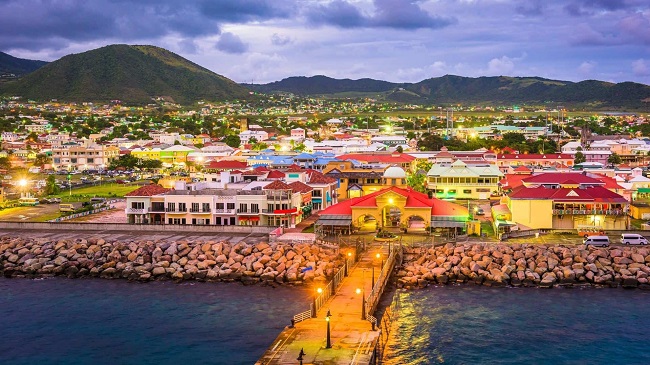Top vacation destination: Saint Kitts and Nevis
[ad_1]
If you are looking to travel out as a Nigerian and need guidance on where to go, Saint Kitts and Nevis is a country you could travel to as a Nigerian. Then, What should you know about Saint Kitts and Nevis?
One of several fun facts about Saint Kitts and Nevis is that the country is a member of the Commonwealth (former British Empire). Also, Saint Kitts and Nevis is an English-speaking nation that gained independence from Britain in 1983; about 77 years after Nigeria gained hers.
1. The Capital City
The capital city of the country is called Basseterre.
2. The People
The citizens of Saint Kitts and Nevis are called Kittitians (or Kitticians) and Nevisians, respectively.
3. Lifestyle
1. Language
The spoken and written language in Saint Kitts and Nevis is English.
2. Religion
According to cia.gov, the distribution of religion in the country is as follows:
Protestant 75.6% (includes Anglican 16.6%, Methodist 15.8%, Pentecostal 10.8%, Church of God 7.4%, Baptist 5.4%, Seventh Day Adventist 5.4%, Wesleyan Holiness 5.3%, Moravian 4.8%, Evangelical 2.1%, Brethren 1.7%, Presbyterian 0.3%), Roman Catholic 5.9%, Hindu 1.8%, Jehovah’s Witness 1.4%, Rastafarian 1.3%, other 5%, none 8.8%, unspecified 0.1% (2011 est.)
3. Population
According to atptranslations.com, the population is 38 756, and the comparison of the country to the world is 142, according to the world fact book.
4. Visa type
The country is visa-free; you do not need to apply for a visa to travel; the tourist visa is free for Nigerians.
5. Currency
As mentioned by bestexchangerates.com, the official currency of Saint Kitts and Nevis is the East Caribbean dollar, with the symbol X$ and currency code XCD.
6. Average cost of living
Below is a breakdown of the average cost of living in this country. Livingcost.org reports the cost of living that the average cost of living in Saint Kitts and Nevis ($1184) is 44% less expensive than in the United States ($2112).
7. Travel cost
According to budgetyourtrip, below is a rundown of travel costs in Saint Kitts and Nevis.
When planning your trip, you would spend an average of EC$671 ($248) per day in Saint Kitts and Nevis, which is the average daily price based on the expenses of other visitors.
1. For a week
On average, a trip to Saint Kitts and Nevis for two people for a week costs EC$9,391 ($3,475). A vacation to Saint Kitts and Nevis for one week usually costs around EC$4,695 for one person. So, a two-person trip to Saint Kitts and Nevis costs around EC$9,391 for one week.
2. For two weeks and more
A two-week trip for two people costs EC$18,782 in Saint Kitts and Nevis. If you’re travelling as a family of three or four people, the price per head often decreases because kids’ tickets are cheaper and hotel rooms can be shared. If you travel slower over a more extended period, your daily budget will also reduce. Two people traveling together for one month in Saint Kitts and Nevis can often have a lower daily budget per person than one person traveling alone for one week. ‘
8. Average Daily Costs
The following is information about Saint Kitts and Nevis, especially about average daily costs to expect in the country, according to budgetyourtrip.
1. Accommodation
The average price for one person for accommodation in Saint Kitts and Nevis is EC$449. For two people sharing a standard double-occupancy hotel room, the average cost for a hotel room in Saint Kitts and Nevis is EC$899.
2. Transportation
Transportation between cities and towns in Saint Kitts and Nevis costs an average of EC$68. Naturally, prices vary by the length of the route, the type of transportation used, and the date.’
3. Food
While meal prices in Saint Kitts and Nevis can vary, the average cost of food in Saint Kitts and Nevis is EC$104 per day. Based on previous travelers’ spending habits, an average meal in Saint Kitts and Nevis should cost around EC$41 per person. Breakfast prices are usually a little cheaper than lunch or dinner. The food price in sit-down restaurants in Saint Kitts and Nevis is often higher than fast food prices or street food prices.
4. Entertainment and activities
Entertainment and activities in Saint Kitts and Nevis typically cost an average of EC$217 per person per day. This includes fees for admission tickets to museums and attractions, day tours, and other sightseeing expenses.
9. Minimum wage
According to minimum-wage.org, the following are basic information on minimum wage in Saint Kitts and Nevis.
1. What is Saint Kitts and Nevis’s Minimum Wage?
Saint Kitts and Nevis’s minimum wage rate is EC$9.00 an hour. The last time according to minimum wage.org, that Saint Kitts and Nevis’ minimum wage was changed was on November 1, 2014.
2. How does Saint Kitts and Nevis’ minimum wage compare to the minimum wage in other countries?
Saint Kitts and Nevis’ yearly minimum wage is $7,954.00 in International Currency- a measure of currency based on the value of the United States dollar in 2009. There are 21 countries with a higher Minimum Wage then Saint Kitts and Nevis, and Saint Kitts and Nevis is in the top 11 percent of all countries based on the yearly minimum wage rate.
10. Crime rate and security
According to www.gov.uk, most visits are trouble-free, but crime incidents have occurred, including murder, armed robbery, and sexual assault.
You should maintain at least the same level of personal security awareness as you in the UK and ensure your accommodation is secure. This also applies if you are staying on a yacht. Be vigilant at all times. Take care when walking alone off the busy main roads and avoid isolated areas, including beaches, particularly after dark.
Only use licensed taxis and take particular care at late-night parties, especially during the festival season.
Date-night large amounts of cash or jewellery. Leave valuables and travel documents in a safety deposit box or hotel safe if possible. You should check that the hotel safe is securely fixed before storing your items.
11. Work permit
According to globalization-partners.com, the following are things to know about how work visas are navigated in the country:
1. Types of Work Visas in Saint Kitts and Nevis
Employees must obtain a business visa for entry if they plan to stay in the country for more than 90 days for business. The government in Saint Kitts and Nevis offers two main types of visas — tourist and business. The average processing time for visas is about two weeks, so ensure your employees apply with enough time to complete the transaction before they need to travel.
After entering the country with the appropriate visa, employees will also need a work permit. Applicants will need to supply information on their medical condition, including a Mantoux skin test and a test for syphilis. They will also need a police record from their current country of residence and a notarized passport identification page.
As the employer, you’ll also need to provide some information to support the work permit application, including evidence that you’ve advertised the vacancy for at least three weeks before hiring a non-national employee.
2. Requirements to Obtain Saint Kitts and Nevis Work Visas
Along with a completed and signed application, the requirements to obtain a business visa include:
- A passport with at least six months of validity remaining.
- Two passport photographs.
- A confirmed itinerary or return ticket.
- An official letter from the employer that guarantees financial support during the applicant’s stay and outlines the length and purpose of the trip.
- Payment of the application fee.
3. Application Process
Because visa requirements can vary depending on your employee’s country of origin, you must begin the application process by contacting your nearest embassy or consulate. You’ll be able to get the latest information on application requirements, immigration policies, and country-specific requirements for your employee through the appropriate embassy.
The application process can be slightly different for each employee, but you can follow some basic guidelines to most effectively manage visa requirements. Ensure you have adequate time to complete these steps to get the appropriate documentation for your non-national workers.
- Speak with the appropriate consulate or embassy about permit and visa requirements for your employee’s specific situation.
- Obtain all the required documentation from your employees, including passport information and photos.
- Submit the relevant documentation and the completed and signed visa application through the government’s secure online site.
- Wait to receive application approval.
12. Top attractions
According to viator.com, the following are top attractions that might tickle your fancy about Saint Kitts and Nevis.
1. Basseterre
St. Kitts’ capital city Basseterre lies on the island’s southern coast in a small protected harbor and is one of the Eastern Caribbean’s oldest towns. After centuries of French and British colonial rule, the city has taken on a delightful mix of European architecture and culture and a laidback island lifestyle.
2. Liamuiga
Soaring to 3,792 feet (1,155 meters), Mt. Liamuiga is the highest point in Saint Kitts and Nevis and the entire British Leeward Islands. Climbing past farmlands and tropical cloud forests to the summit offers an invigorating adventure and an unparalleled vantage point for taking in the stunning expanses of the Eastern Caribbean.
3. Kitts Scenic Railway Tours and Tickets
Originally built to transport sugar cane, the St. Kitts Scenic Railway is a unique way to explore a Caribbean island. The train winds along the island’s coastline, past cane fields and abandoned plantations, providing visitors with panoramic views along the way.
4. Old Road Town
Founded on the west coast of St. Kitts, Old Road Town was settled in 1624 by a small group of settlers interested in trying their hand at tobacco farming. Old Road Town was the first settlement in the Caribbean established by the British. Highlights include a thriving farming industry, a historic Wingfield Estate, and several ancient Carib petroglyphs.
5. Bath Hotel and Spring House (Old Bath House)
Built in 1778, the once opulent Bath Hotel and Spring House was the Caribbean’s first tourist hotel, with the international jet set flocking to its therapeutic hot springs. While it’s no longer a hotel, the volcanic baths and the relaxing landscaped gardens are open to the public.
6. Bloody Point
Bloody Point along the western coast of St. Kitts is named after a tragic historical event in 1626, when French and British colonies were being developed on the island, each claiming the land as their own. As they expanded, the original native Carib Indians, led by Chief Tegremare, attacked the colonizers. But since the two nations had learned of his plan beforehand, they banded together, killing over 2,000 natives.
7. Wingfield Estate
In the foothills of St. Kitts’ central mountain range, Wingfield Estate is a 17th-century sugar plantation initially owned by Sam Jefferson, the great-great-great-grandfather of Thomas Jefferson. It was the first working estate on the island for tobacco, sugar and rum, and while here, you may inspect the ruins and visit the rum distillery to learn how sugar was converted into rum back in the day.
8. Timothy Hill
For a gorgeous view of St. Kitts and the neighboring island of Nevis, head up to the top of Timothy Hill. On this popular lookout spot, the Atlantic Ocean meets the Caribbean Sea at the island’s southeast peninsula. See Friar’s Bay and Frigate Bay below, alongside green, gently sloping hills falling into the water below.
9. Berkeley Memorial
In the middle of the Circus—a roundabout named after London’s Piccadilly Circus—in the center of Basseterre, the Berkeley Memorial is an ornate green tower built in 1883 in honor of Thomas Berkeley, a legislator and owner of several estates on St. Kitts. It has a drinking fountain at the bottom and a clock with four faces on the top.
10. Brimstone Hill Fortress National Park
Set atop a steep volcanic hill overlooking the Caribbean Sea, Brimstone Hill Fortress is a fascinating UNESCO World Heritage site and feat of engineering. Designed by the British and built by African slaves, the fortress was finished in 1790 after 100 years of construction. Though fitted with powerful cannons, the fort fell after a month-long siege by the French.
Above all, be attentive to the process of learning about this country before you take steps to travel.
ALSO READ FROM NIGERIAN TRIBUNE
[ad_2]















Post Comment